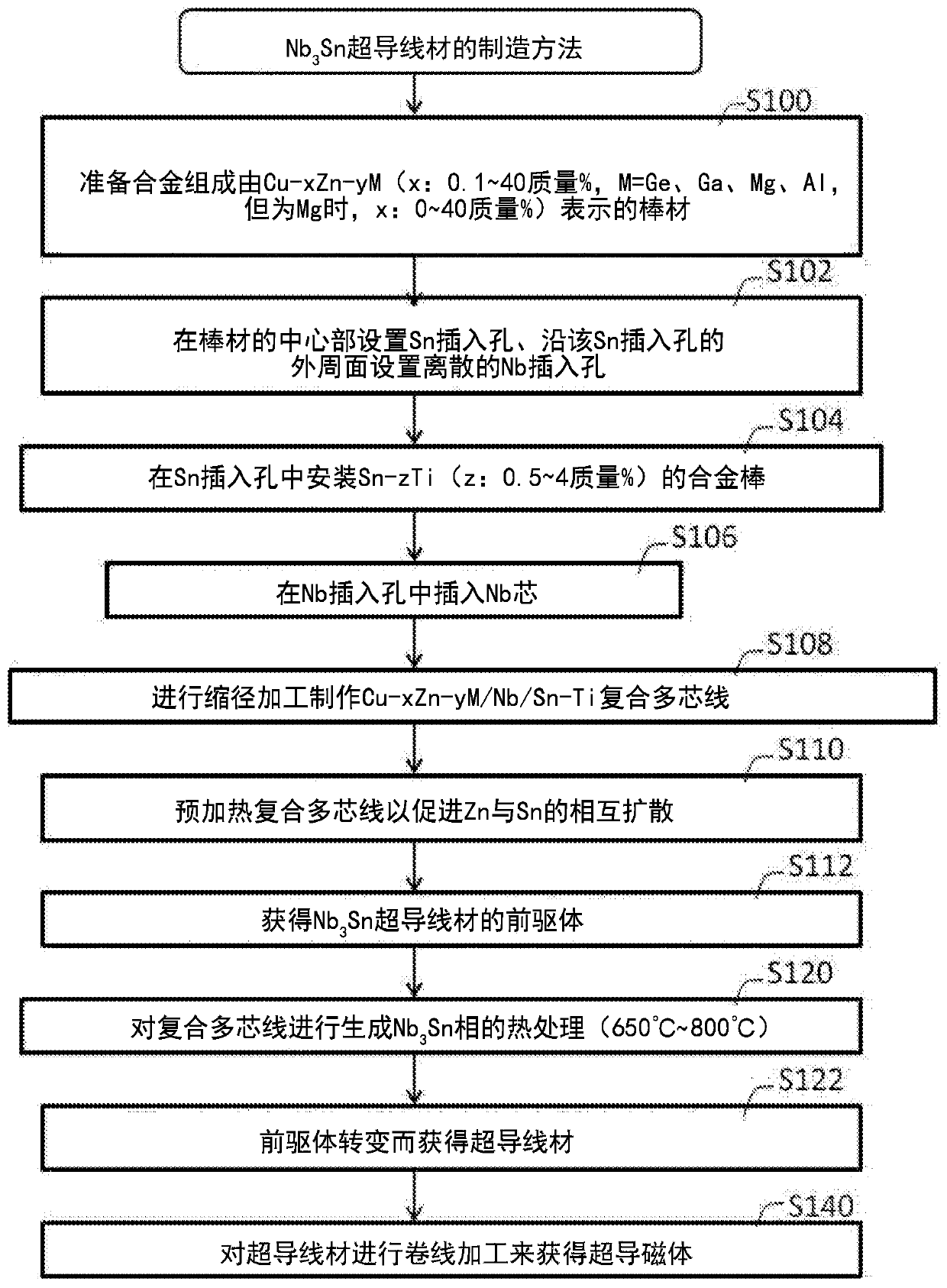Production method for nb3sn superconducting wire rod, precursor for nb3sn superconducting wire rod, and nb3sn superconducting wire rod using same
A technology of superconducting wire rod and manufacturing method, which is applied in superconducting/high-conducting conductor, cable/conductor manufacturing, usage of superconducting element, etc. Effects of strain characteristics
- Summary
- Abstract
- Description
- Claims
- Application Information
AI Technical Summary
Problems solved by technology
Method used
Image
Examples
Embodiment 1
[0084] Follow the steps below to create image 3 The cross-sectional shape of the precursor is shown. First, a Cu-1Zn-5Ge bar material with an outer diameter of 30 mm (it should be noted that in this example, copper was arranged at the center to improve workability) was prepared as a base material 10 (S100). Next, a hole with an inner diameter of 2 mm was opened in the center of the base material 10 as a Nb insertion hole. Next, a total of 20 holes were drilled along the first outer circumference and the second outer circumference around the central hole as Sn insertion holes 12 . In addition, a total of 36 Nb insertion holes 14 are provided between the third outer periphery located on the outer periphery of the Sn insertion hole 12 and the fourth outer periphery that is inside the outer peripheral surface of the Cu-1Zn-5Ge rod material as the base material (S102). That is, there are 37 Nb insertion holes 14 in total.
[0085] Next, a Sn-2 mass % Ti alloy rod having a diame...
Embodiment 2
[0092] For a composite precursor wire with a wire diameter of 0.814mm prepared in the same way using the Cu-1Zn-10Ga alloy base material, after preheating at 650°C×100h in an Ar gas atmosphere, in order to generate Nb 3 The Sn layer is heat-treated at 750°C×100h.
[0093] As a result of composition distribution analysis, it was confirmed that Ga diffused into Nb after heat treatment 3 Sn layer. When the magnetization-temperature curve of this sample is measured by SQUID, if Figure 5 As shown, it was confirmed that the critical temperature for becoming a superconducting state increased by 0.3K compared to the case where Ga was not added.
Embodiment 3
[0095] For the composite precursor wire prepared in the same way using the Cu-0.2Zn-1Mg alloy base material, after preheating at 650℃×100h in an Ar gas atmosphere, in order to generate Nb 3 The Sn layer is heat-treated at 800°C×20h.
[0096] SEM observation was carried out on the fractured surface of the wire rod, and it was found that the average crystal grain size of the Cu base material without adding Mg was about 500 nm or more, while the coarsening of the crystal grains of the base material with Mg was suppressed, and the average grain size was . Around 300nm.
PUM
| Property | Measurement | Unit |
|---|---|---|
| thickness | aaaaa | aaaaa |
| critical temperature | aaaaa | aaaaa |
Abstract
Description
Claims
Application Information
 Login to View More
Login to View More - R&D
- Intellectual Property
- Life Sciences
- Materials
- Tech Scout
- Unparalleled Data Quality
- Higher Quality Content
- 60% Fewer Hallucinations
Browse by: Latest US Patents, China's latest patents, Technical Efficacy Thesaurus, Application Domain, Technology Topic, Popular Technical Reports.
© 2025 PatSnap. All rights reserved.Legal|Privacy policy|Modern Slavery Act Transparency Statement|Sitemap|About US| Contact US: help@patsnap.com



